Micro And Stealth Cannabis Growing
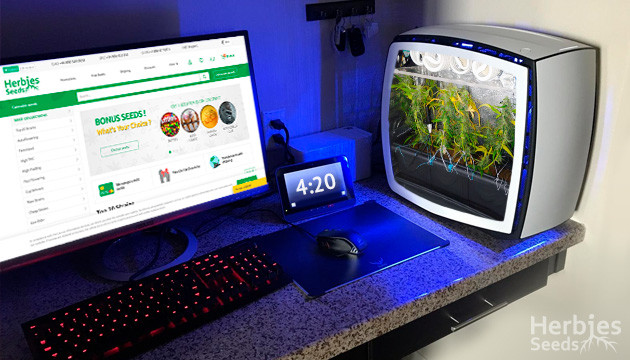
If you don’t have the space for more than a few plants, considering a cannabis micro grow is a good call. You only need a couple square meters to get started, whether that’s in your closet, dresser or out in the garden. Even though a micro grow is a small operation, that doesn’t mean it isn’t still a lot of work! You’ll have to pay special attention to detail, taking into consideration the lighting, environment and strain.
How Does Microgrowing Work?
The focus here is on microgrowing, which in itself is a stealthy way to grow your cannabis. It works by growing in a confined space and adjusting the essentials for your plant to grow healthily: water, food, air and light. Microgrowing is perfect for a few plants in a small space like a closet. To maintain a discreet operation and keep plants small, the grower needs to pay special attention to the wattage of the lights, the amount of fertilizer used, soil vs. hydro growing and strain. Your main objective is to create and maintain optimal conditions for your cannabis plants to flourish in a restricted space.
Tips And Tricks For Stealthy Growing

If you prioritize stealth, indoor growing is your best option because you control the odor and sound – and of course, your plants aren’t in view. Outdoor growing can be risky for several reasons. If you choose to do it off your property, there’s the chance that the grow could be discovered or destroyed by strangers. If you decide to grow outdoors in your own garden and want to stay under the radar, you’ll have to train your cannabis to stay bushy and out of sight by pruning and topping the plant. There are also strains that are less smelly, such as Northern Lights or Blueberry. Other plants like lavender, honeysuckle, and jasmine can also cover up the smell of your cannabis plants.
Indoor growers, on the other hand, have to deal with these issues in another way. You’ll have to control the odor of your plants with filters and duct fans in the grow room, and possibly use odor neutralizers like candles and diffusers for main living areas. Fans are also noisy; the smaller or higher quality the fan, the quieter it will be. Insulating the grow space with egg crate material or foam can also help with reducing noise. Finally, be discreet with your waste; consider tossing your cannabis-related garbage on trash day.
Overall, be smart, attentive and quiet! Indoor grows remain more easily undetectable, especially when you consider the options for discreet grow boxes.
What Space To Pick For Your Micro Grow
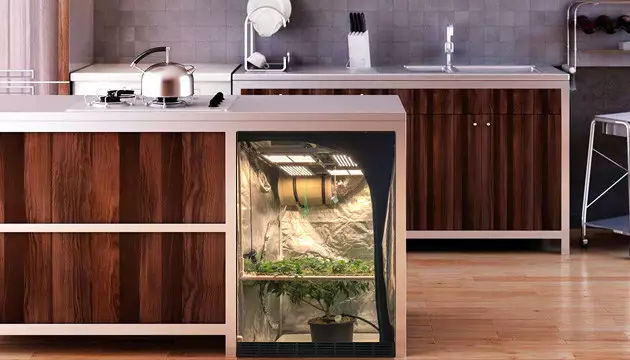
The ideal space to pick for your indoor micro grow would be a grow tent. These typically have vent ports for fans and fresh air already built in, are lined with reflective material on the inside and are generally good at keeping bugs out. If you’re looking for something more discreet than a grow tent, it’s popular to transform your closet into a micro grow space. This can be easier than setting up a tent, since you only need to install fans and lights, and line the walls with reflective material before you get started. Otherwise, stealth grow boxes are also a clever way to hide your grow from curious eyes. Many are disguised as a bedside table or dresser, or are even hollowed-out PC towers converted into stealth micro grow boxes, which are great for hiding light and disguising the sound of fans.
Save Space With The Right Strain
Choosing the right strain is important for microgrowing. Sativas are taller, more slender plants than Indicas, which are typically short and stocky. Watching out for height is essential, because plants can burn if they get too close to the lights. Keep in mind that plants grow exponentially during the flowering stage, which should be accounted for in the vegetative stage and while planning your grow space. If size could be a problem, an autoflower micro grow is right for you! Autoflowering strains have a short vegetative stage (3-4 weeks), which means they don’t grow very tall before they begin to flower. Our recommendations for autoflowering strains? Why not try Royal Dwarf Auto if you’re looking for a Sativa, or Auto White Widow if you’re more interested in some Indica vibes.
Aside from choosing a shorter strain, there are also training methods for keeping plants short like topping and low stress training, which we’ll touch on later.
Managing Your Medium: Soil Or Hydro?
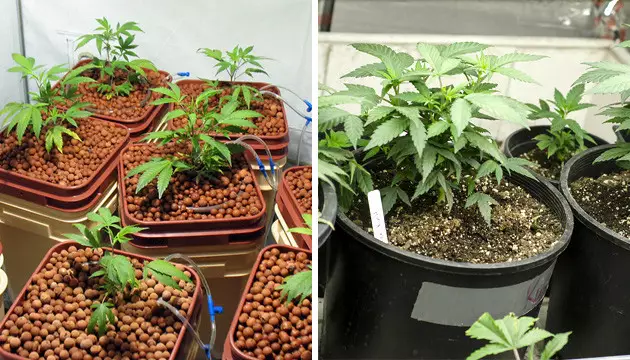
You can control the potential size of your plant by how much soil you give it. The root system in cannabis plants is essential for the plant’s development, since that is where it gets all of its nutrients and water. Use this to your advantage! For example, an average plant needs about 12 liters (3.17 gal) or more of soil. Reducing the amount of soil to around 5 liters (1.3 gal) will result in a shorter plant of up to 60cm (2ft), while halving that amount of soil will lead to a plant of 24-30cm (0.8-1ft) in height. If you’re going to be using less soil, make up for that in extra fertilizer and water your plants to keep them healthy!
Using a stealth hydroponic grow box can decrease the amount of space you need, but requires more materials. The biggest downside to hydroponic systems? Honestly, maintenance. The water reservoir needs to be cleaned out regularly, otherwise you’re at risk for moldy roots that destroy the plants. Keep an eye on the temperature and humidity, because mold thrives in hot, moist conditions.
The Ideal Lights For Microgrowing
If you want your cannabis to grow, you’re going to need light. The better the lighting, the better the quality of your cannabis! We recommend using either LEDs or CFLS (compact fluorescent lamps), as they don’t give off as much heat as other bulbs. When deciding on your light setup, keep a close eye on the wattage and heat produced. Ideally, you should have around 100W of light per plant.
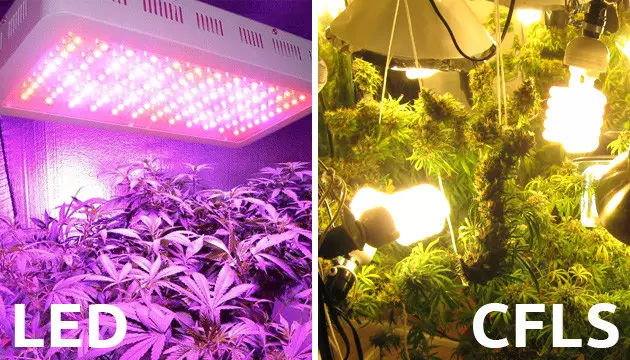
LEDs
LEDs are perfect for growers with limited growing space, although LED tubes can be a little pricey. They produce a little heat, but this shouldn’t be a problem as long as you’re within the recommended wattage and ventilate your space. If your light is too strong, it won’t burn your plant, but the intense light can actually bleach the leaves and diminish growth. Somewhere between 270-360W should be perfect for a micro grow using LEDs.
CFLs
Compact fluorescent lamps (CFLs), both bulbs and tubes, are great because they’re energy-efficient and super bright without giving off a lot of heat. You might not get the same yield as with LEDs because of the limited light strength in comparison, but the option for different light colors makes up for these shortcomings. Cannabis in the vegetative stage likes more blue light, but requires more red light in the flowering stage. Using different CFLs for different stages gets the job done!
Plants Also Need Their Vitamins and Minerals!
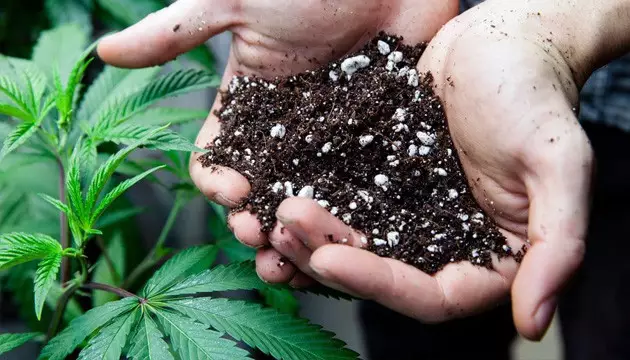
Since you’re working with fewer plants, you’ll have to scale down the amount of plant food you use. You should first calculate the water-to-nutrient ratio recommended by your feeding chart, then divide that by half. Your plants are supposed to stay small in a micro grow, so they won’t need nearly as many nutrients as a larger plant would. Here’s a tip: you’re giving your plants too much nutrition when their leaves get yellow and wilted (also known as nutrient burn). Don’t fret – you just need to scale down your nutrients by 25% and then gradually increase after that if necessary.
Environment Control: Heat, Humidity, Pests
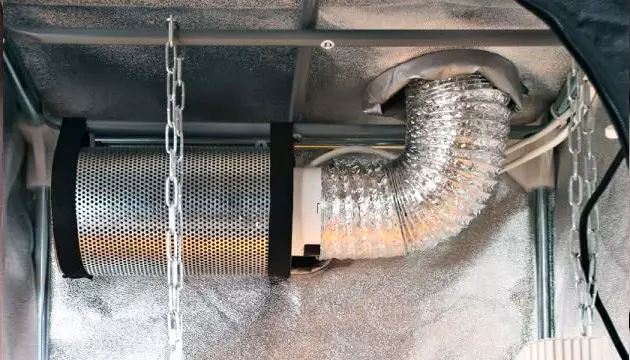
When it comes to environment control, the most important ways to manage it concern the filtration, air flow and temperature. Air circulation is vitally important to growing cannabis, because carbon dioxide is quickly used up and needs to be replenished so that the plant can continue to develop. There are many types of fans available, and it’s recommended to place the intake at a low point in your grow space, and another higher up as an exhaust fan. Heat rises, and the hot air needs to be pushed out of the space to avoid drying out the plants, maintain an appropriate temperature and keep the humidity in check. Heat from the lights can be dangerous if your plants get too tall and get scorched, so stay diligent in your maintenance! Make sure to also include filters with your fan setup to keep dust, mold and pests away from your precious plants!
Try Training!
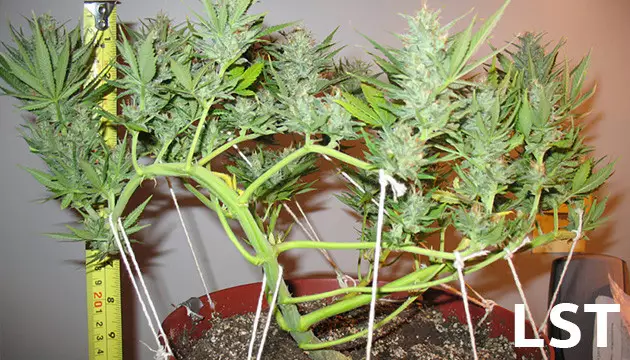
There are several ways to keep your cannabis plants as small as possible. Aside from autoflowering strains, which are usually small, and hydro systems which eliminate the space needed for soil, you can also train your cannabis plants to grow differently. You can influence plant growth by topping and low stress training, for example, to not only keep them at a desired height but also to potentially increase yield. These techniques mostly involve bending or trimming the top of the plant, thus exposing lower branches to more light. Check out our article on low stress training (LST) and high stress training (HST) methods to learn more.
Sometimes, The Smaller The Better!

Stealth microgrowing setups are great for growers who don’t have a lot of space or would simply like to keep their plants hidden safely away. Do you have any recommendations for stealth micro grow boxes? The PC box is a clever way to keep your cannabis hidden, but if you have any other fun ideas, feel free to share in the comments below!
Herbies Head Shop expressly refuses to support the use, production, or supply of illegal substances. For more details read our Legal Disclaimer.



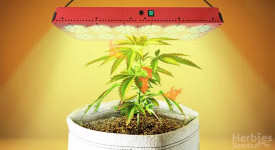
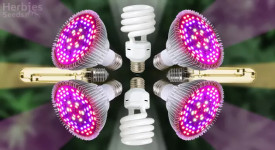






Thank you for leaving a comment for us!
Your feedback will be posted shortly after our moderator checks it.
Please note that we don’t publish reviews that: